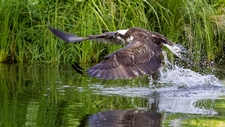Food Chains

TEKS Objective
The student is expected to compare and give examples of the ways living organisms depend on each other and on their environments such as food chains within a garden, park, beach, lake, and wooded area.
Essential Understanding
The student knows that living organisms have basic needs that must be met for them to survive within their environment.
Science Background
Food Chains and Cycles: BBC Bitesize (website) - Food chains illustrate the feeding relationship between living things. Learn more about the transfer of energy through food chains as you navigate this website.
Food Chains and Cycles
BBC Bitesize, www.bbc.co.uk
Food Chains and Food Webs: Virtual Teacher Aide (website) - Our bodies use energy every time we move or exercise or walk in the park. Where do we get the energy to do these things? Read this article about food chains and food webs helps to answer this question, and more.
Food Chains and Food Webs
Virtual Teacher Aide, www.vtaide.com
Signature Lesson
The Food Connection: SeaWorld/Busch Gardens (PDF) - Use food chains and food webs to help students compare and understand the relationships and dependencies among organisms in an ocean ecosystem.
The Food Connection
SeaWorld/Busch Gardens, www.swbg-animals.org
- Supporting Lessons
- Extensions
- Assessment Ideas
- Literature Connections
- Related
TEKS - Additional Resources
Supporting Lessons
Food Chain: Science NetLinks (website) - Explore the flow of matter and energy, and interdependence of life represented in food chains. Students learn to identify similarities and differences among a variety of food webs in different environments. Includes assessment and extensions.
Elaboration Lessons and Extensions
Exploring the Native Plant World: Lady Bird Johnson Wildflower Center (PDF) - Use Activity 2.2 (“The ‘Wander’ Pollen”) on pages 9-11 to compare and learn how different living organisms depend on each other and their environments to survive.
Assessment Ideas
Have students create/draw their own food chains to turn in for review. Post students’ work in a place that the entire class can view and benefit.
Literature Connections
The Magic School Bus Gets Eaten: A Book About Food Chains. Relf, P. and Bracken, C. (ISBN-13: 978-0590484145)
Meadow Food Chains. Kalman, Bobbie and MacAulay, Kelly (ISBN-13: 978-0778719915)
City Food Chains. Vogel, Julia (ISBN-13: 978-1602707917)
Who Eats What? Food Chains and Food Webs. Lauber, P. and Keller, H. (ISBN-13: 978-0064451307)
On One Flower: Butterflies, Ticks and a Few More Icks. Fredericks, A. (ISBN-13: 978-1584690870)
Additional Resources
Our World, Honeybees: NASA eClips (video) - Join NASA scientists and beekeepers in a citizen science project to collect important data about climate change. See how honeybees pollinate more than 130 crops in the United States each year and learn how NASA is helping research of the decline in bee populations. (Scroll down the list of videos and click on the “Honeybees” icon.)
Our World, Honeybees
NASA eClips, www.nasa.gov
Food Chains: Brain Pop (website) - From the tiniest shrimp to the largest whale, all living things are part of a food chain. This cute animation explains food chains, food webs and energy pyramids, and illustrates why every creature plays an important role.
TEKS Navigation
Grade 2
Need Assistance?
If you need help or have a question please use the links below to help resolve your problem.

Comments